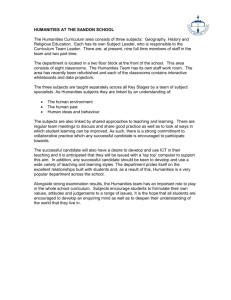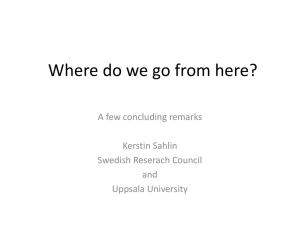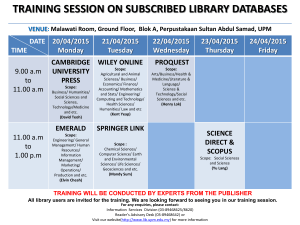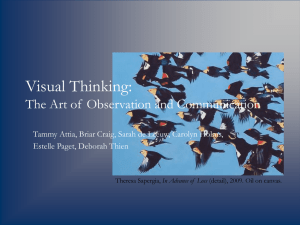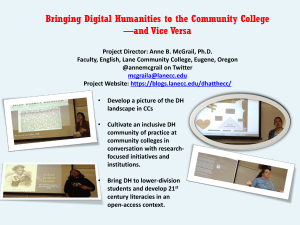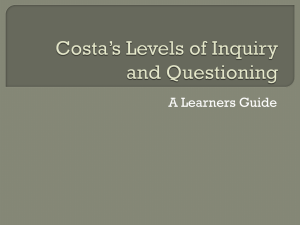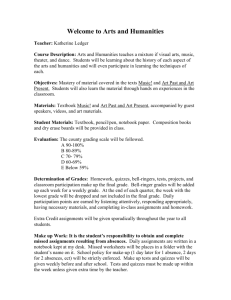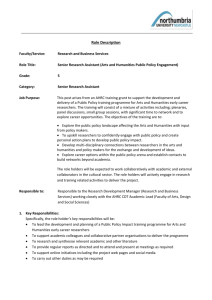PROGRAM REVIEW: HUMANITIES CLUSTER
advertisement
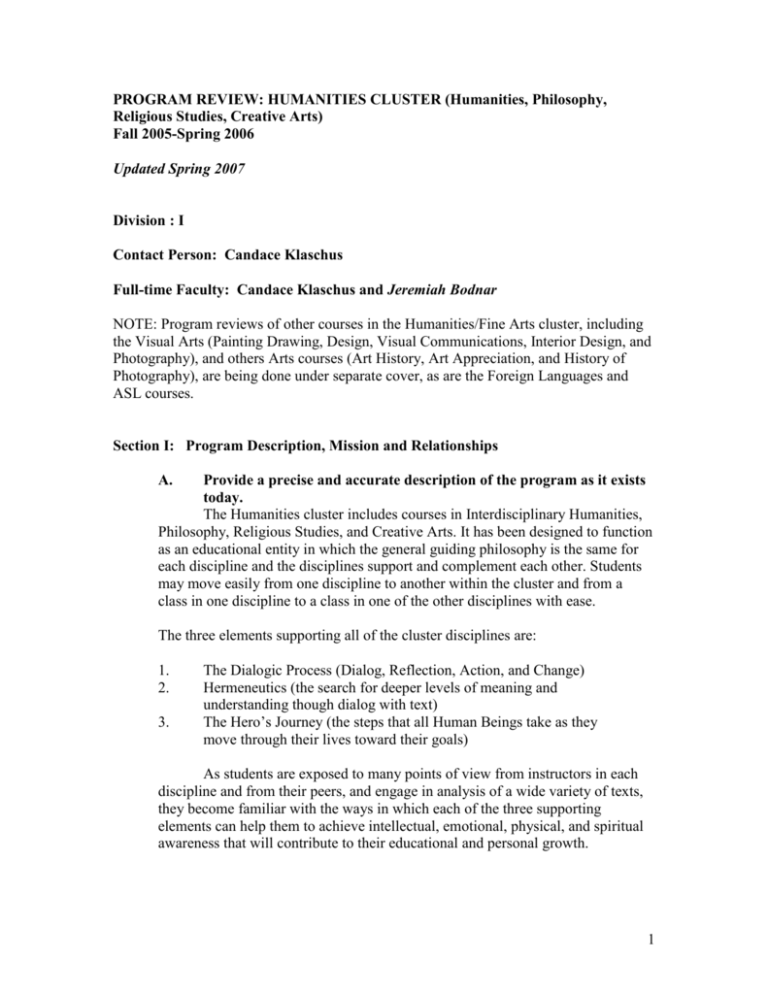
PROGRAM REVIEW: HUMANITIES CLUSTER (Humanities, Philosophy, Religious Studies, Creative Arts) Fall 2005-Spring 2006 Updated Spring 2007 Division : I Contact Person: Candace Klaschus Full-time Faculty: Candace Klaschus and Jeremiah Bodnar NOTE: Program reviews of other courses in the Humanities/Fine Arts cluster, including the Visual Arts (Painting Drawing, Design, Visual Communications, Interior Design, and Photography), and others Arts courses (Art History, Art Appreciation, and History of Photography), are being done under separate cover, as are the Foreign Languages and ASL courses. Section I: Program Description, Mission and Relationships A. Provide a precise and accurate description of the program as it exists today. The Humanities cluster includes courses in Interdisciplinary Humanities, Philosophy, Religious Studies, and Creative Arts. It has been designed to function as an educational entity in which the general guiding philosophy is the same for each discipline and the disciplines support and complement each other. Students may move easily from one discipline to another within the cluster and from a class in one discipline to a class in one of the other disciplines with ease. The three elements supporting all of the cluster disciplines are: 1. 2. 3. The Dialogic Process (Dialog, Reflection, Action, and Change) Hermeneutics (the search for deeper levels of meaning and understanding though dialog with text) The Hero’s Journey (the steps that all Human Beings take as they move through their lives toward their goals) As students are exposed to many points of view from instructors in each discipline and from their peers, and engage in analysis of a wide variety of texts, they become familiar with the ways in which each of the three supporting elements can help them to achieve intellectual, emotional, physical, and spiritual awareness that will contribute to their educational and personal growth. 1 All of the courses in the Humanities cluster are transferable to schools in the CSU and UC systems as well as to many private colleges and universities. We believe that our courses offer a solid grounding in skills that provide an excellent foundation for many vocations. First of all, our emphasis on the universality and infinite variety of human experience opens students to greater understanding of the world’s peoples and cultures. For example, although a student may not be trained specifically to enter into the business world, his or her Humanities background has provided a matrix on which to build the specific skills for that field. The dialogic process exposes students to previously unfamiliar modes of discourse, as well as the opportunity to think carefully about the new information they are acquiring, and whenever possible to use the knowledge to understand, empathize with, and serve others. The hermeneutical engagement with a wide variety of texts (whether they be visual such as painting or photography, aural, as in music or rhetoric, or literary, or even in other forms such as dance and drama) cultivates the critical thinking skills necessary for success in almost any endeavor. As students (and instructors) move along the paths of their hero’s journeys, the Humanities help them to become more capable of making humane and ethical decisions based on rational and well-reasoned consideration of the information. One special quality of the Humanities not shared by all disciplines is that aesthetics is one of the primary components of all our courses. We encourage our students to seek out, identify, and create beauty all around them and to bring beauty to others who may not have discovered it in their own lives. We develop their abilities to “re-see” the world through different eyes, possibly in ways that had not previously occurred to them. This is often the first time students have ever been asked to imagine the world from multiple points of view, and many of them find it an exciting and even liberating process. B. What is the program’s mission? Our mission is to provide high-quality transferable courses to those students interested in Interdisciplinary Studies, Humanities, Philosophy, or Religious Studies majors for successful transfer to four-year institutions. Students not planning on transferring have access to the great ideas of many cultures through the study of artistic works, as well as literary, philosophical and religious texts. C. What is the program’s relationship to the College’s mission? Our courses are a key component of any student’s education. They fulfill criteria for attaining an associate degree and for transferring to four-year institutions. D. How does the program help fulfill the College’s mission? We strive to foster success through the commitment of our exceptional faculty. We cultivate the skills of critical thinking; an understanding and respect 2 for difference and diversity; the ability to make humane, informed, and ethical decisions; and the desire to participate in society as responsible citizens. We highlight the diversity of world cultures and thus help promote tolerance and mutual respect. Fostering discovery and nurturing creativity are central to many of our courses. And above all, we underscore the belief that each person who comes through our doors does indeed make a difference. E. What is the program’s connection to other programs? Courses in the Humanities cluster connect to other programs by providing cultural information that can act as a foundation for the information contained in other disciplines. A great deal of reciprocity is present between the Humanities and many other disciplines. Generally, the skills of critical thinking and analysis of texts the students acquire as a result of the hermeneutical process would aid them in almost any other course they might take. For example, if students have learned how to critically examine ideas posed in philosophy about humans’ relationship to the cosmos, and then take an astronomy course where questions about the physical nature of the universe are posed, it seems as if they would be better able to understand the ideas on both the metaphysical and physical levels. (After all, for much of human history, philosophers were scientists.) To suggest another possibility: Many Humanities courses focus on what it means to be creative, and what the creative process entails; similar issues will be raised in many English courses. Questions of psychology often arise in Humanities courses, especially when analyzing texts or discussing artists’ work. Students who have taken Humanities 28 (Classical Mythology) or Humanities 35 (Greek Tragedy) can use knowledge from those courses to help them in archaeology, history, or anthropology courses, just as students who have had Ancient History might apply that knowledge to the mythology course. From a practical standpoint, students studying film, as they do in Humanities 44, Humanities 3, and Humanities 10, also can use the computer skills they learned in computer courses to understand the technical aspects of film and even to help them make their own movies and videos. This reciprocal relationship is possible even in areas that might not be immediately evident. Students in automotive technology might, for a Humanities 10 class in which they have been learning about the cultural importance of automobiles, visit the Blackhawk Auto Museum, where they could become aware of the aesthetics of cars; combine this with their mechanical knowledge, and they are able to more fully appreciate the significance of the car in American and world culture. 3 Section II: Program Function and Assessment A. Program Access In this category, it seems as if the enrollments have remained on a fairly steady pattern with increases each spring, perhaps indicating that students return to take more courses in the cluster after initial exposure in the fall term. We have increased the total number of sections offered each spring to accommodate this trend. Besides the traditional full-term classes, we provide fast-track, late-start, and web-based versions of many courses. We also offer courses on Saturdays and as part of the Weekend College. B. Program Resources 1. Human There is one full-time Philosophy instructor and one full-time Humanities instructor. Numbers of part-time faculty vary according to need. 2. Physical Currently, Humanities classes are taught in rooms campus-wide, with the bulk in Building 2200. It is sometimes difficult to find the right spaces for the courses, especially those that require “smart” technology in order to show films or listen to music; or if the class needs to break into small groups. Often is difficult to do that in rooms with large tables, or (if the class is in Building 1800 as some are) with tables that do not move at all. It is possible that these problems have a negative impact on enrollment. It is hoped that the Multi-disciplinary Classroom Building, scheduled to open in 2007, will give the program more opportunities for innovative teaching. 3. Technology It may seem surprising that the Humanities rely heavily on technology for the most effective implementation of our courses, but this is indeed the case. Our Distance Education sections have been successful, so it seems logical that the addition of a DE classroom would be welcome. In addition, many Humanities instructors have experienced ongoing, and frustrating, difficulties because of outdated or non-functioning computers and other equipment in the classrooms. We are in great need of high-quality equipment for our classrooms. It is hoped that the college will recognize the urgency of this problem and take immediate steps to address the issue, because it has a dramatically negative effect on our ability to deliver a high-quality educational experience to our students. (See Section III B for details.) Beginning in Fall 2007, the equipment in the classrooms has been up graded, and it seems to be working well. It is hoped that this will be the case in the future. 4 4. Financial The amount the Humanities Cluster receives has been sufficient for any necessary supplies. However, funds available, though staff development, for travel to conferences or other scholarly activities, is limited and has a negative impact on the instructors’ ability to pursue research. It would also be useful if money were available for staff development, especially for paying adjuncts to participate in workshops. Although part-time instructors often would like to participate in meetings and workshops, it is often the case that they simply cannot afford to do so. If money were available to pay them something more than a tiny token stipend, they might be more willing to more fully engage in extra-curricular activities. C. Program Efficiency Courses in the Humanities cluster offering a good balance of day, evening, and Saturday classes, and of campus-based and distance education sections. Our fill rates have been very good: Humanities: 94 to 79 percent average enrollment WSCH/FTEF 553.50 FTES 36.25 Philosophy: 113 to 82 percent average enrollment WSCH/FTEF 655.63 FTES 33.74 Religious Studies 112 to 72 percent average enrollment WSCH/FETF 510.00 FTES 510 Creative Arts 56 to 36 percent average enrollment WSCH/FTEF 240.00 FTES 1.60 (Figures are from Fall 2002-Spring 2005) The lower rates in Creative Arts may suggest that we consider offering that course only once a year, or once every third semester. D. Student Success Grades indicate that students in the Humanities cluster courses succeed (grade of C or higher) at rates ranging from 67 to 87 percent. Retention rates range from 79 to 100 percent. It might be worth noting that the highest success rate (87 percent) and the highest retention rate (100 percent) are both in the Creative Arts course, which have the lowest enrollments. 5 E. Student Input Other than official course evaluations and unofficial and at best anecdotal evidence from students, the Humanities cluster does not have any consistent input from students regarding the effectiveness of its program. F. Dialogue with other programs The Humanities cluster has not in the past had very much formal dialogue with other programs; this may be an area in which we could improve. Certainly the interdisciplinary nature of our courses lends itself well to drawing upon the expertise of colleagues from other disciplines such as history, anthropology, psychology, and the performing arts. A less obvious but certainly interesting possibility would be collaboration with colleagues in computer science. G. Other data, such as advisory boards, transfer institutions, student input The Humanities cluster has in the past been active in supporting events on campus, including the World Cultures Alliance and the Art Club. We promote all the performing arts activities. We participate in Transfer Day and the Major Faire, and since all of our courses transfer to the CSU/UC systems, we work with our students to make sure they are taking what they need. Section III: A. Assessment and Recommendations Program Strengths The strengths of the Humanities program are evident from the enrollment data. The courses we offer are wide-ranging and among the most varied in the state; in fact, in terms of the type and variety of course we offer, we are certainly among the leaders in the California community college system. The courses are well-enrolled and the fluctuations predictable, which enables us to plan efficiently and be reasonably sure that the courses will be filled. Such strong enrollment may point to the advantage of having a staff of outstanding and experienced instructors, whose often innovative teaching techniques keep students engaged. Our instructors often encourage students to try non-traditional types of projects in order to stretch themselves; they go beyond the usual term papers and tests, with the result that students often discover talents within themselves that they never dreamed they possessed. Our instructors also make use of the technologies available, including distance education and Blackboard. Since students often make decisions about what courses to take based on who the teacher is, positive word-of-mouth is a significant factor in decisions students make about which classes to take, and it seems that the Humanities cluster has benefited from this practice. 6 One area from which the Humanities program has benefited greatly in the past two years is the growth in the library’s collections of DVD’s and CD’s. It is extremely helpful to have so many fine films and music to choose from and to recommend to students. The librarians also do an excellent job of ordering books and they have been extremely responsive whenever a reasonable request is made for any material that we need. Additionally, the library staff, especially the reference librarians, do an outstanding job of helping the students on their research projects. One hears again and again how helpful the librarians are, and without them students would not be as successful as they are in their work. B. Please summarize the barriers, if any, you experience in fulfilling your mission. You may include such issues as curriculum, outreach, resources (human, physical, technology, financial), access and other factors that limit the program’s success. 1. Curriculum While our instructors are the most important factor in our success, it is a drawback to have only two full-time instructors in the cluster. The addition of another full-time Humanities teacher would enable the program to grow and develop in a number of ways. While we currently strive to provide a varied curriculum, in coming years, we will in all likelihood face an increasingly diverse campus population. It is important that the Humanities offerings be able to change and grow to serve this population. With that in mind, another full-time Humanities instructor would be able to help develop more courses in ethnic studies (for example, interdisciplinary courses on Asian and Middle Eastern art and culture). Second, Humanities 44, Narrative Film Music, is a very popular class, and informal surveys of students indicate that they would welcome not just more sections of Humanities 44, but new film courses. And in a third area, we already are seeing students who have grown up using computers and playing video games, yet our courses seldom address the aesthetics of these areas. These are just a few of the possibilities for new courses, yet it would be impossible for us to continue to offer the highquality classes we give now and include these new ones on a regular basis. And it is important that the courses be offered regularly, not just on a hit-and-miss basis. 2. Technology As I indicated in Section II D, access to high-quality technology is an ongoing concern, not only for instructors in their offices, but also in the classrooms, where it has a direct and often negative impact on student learning and student success. It is disheartening, to say the least, when they encounter such problems. Since my employment as the full-time Humanities instructor in January 7 2004, I have encountered problems while trying to show films in my courses. First, some of the rooms are too light in the daytime; blackout curtains are needed. Second, many instructors have had ongoing problems with the computers in the 2200 Building, and some with the computers in PE 209 as well. I use DVD’s in all of my courses and in some, such as Humanities 44, Narrative Film Music, they are critical to being able to teach the course. Far too frequently the computers in 2201, 2204, 2205, 2206, and 1826 have not been capable of playing a DVD, so I have had to switch to using a DVD player. This may seem like a small problem, but the computer is an efficient way to teach: I can be cueing up the next scene while I am talking about the topic. With the DVD player, I have to go through the menu, find the scene, cue it up, and sometimes fast forward or rewind to get to the spot I need. All of this is very time-consuming and of course distracting for the students. Another, and even more serious problem, is that students often have better equipment at home than we do in the classroom. They will prepare presentations by burning their own DVD’s (a process which often takes many hours of work on their part), only to discover that the classroom computer cannot accommodate their equipment. Since these presentations are a major part of the students’ grades, it seems clear that such problems will have a detrimental effect on student learning and possibly, if they are not corrected, on student retention. Access to technology has improved over the past year, and it is hoped that the college will continue to provide the classrooms with the highest quality equipment. We could also use at least one digital camera in order to take photos of our students’ projects. As mentioned in Section II B, class projects may take nontraditional forms, such as paintings, sculptures, or models. Obviously we have no space to store such projects, and often the students are justly proud of their work and want to keep it. In order to archive these (as we would written documents), we need to be able to take pictures of them which could easily be digitized and kept on disk files. This would also aid us in being able to “display” our students’ work in the future. In a similar vein, good sound and video recording equipment would enable us to capture students’ in-class performances. C. Please describe the status of SLO (Student Learning Outcomes) in your program. Instructors in the Humanities cluster have begun working to develop an overall philosophy regarding Student Learning Outcomes for our courses. Because of the nature of our courses, student learning outcomes may look somewhat different from those in other disciplines. In many ways, our courses resemble those in which students develop new skill sets, rather than those in which a great deal of factual information is provided. Our students learn new ways of seeing, listening, and reflecting upon a variety of texts; those skills are more difficult to quantify and to assess. Nevertheless, we are confident we will be able to develop student learning outcomes and means of assessment that are pedagogically sound. It seems certain that some of the means by which we assess 8 students, and archive the results of the assessments, may rely more on technology than in the past. (See Section III B.2.) D. Please identify areas for improvement. What are some ways to close the gaps between the mission and program function? If you had anything you needed to fix the problems, what would you do? Besides those items covered in Section III B above, the Humanities program recognizes that we need to do more outreach to students and teachers, especially those in the local high school districts, to let them know what we are doing in our courses and to find out if they have any areas in which they might suggest we strengthen our curriculum. Anecdotal evidence from LPC students in the Humanities classes suggests that a number of local high school instructors are quite engaged in their Humanities teaching, and it would benefit all of us to find out more about these courses and instructors. Another area that needs addressing is the time instructors have to spend doing paperwork. Obviously any institution requires a certain amount of recordkeeping, but it often seems overwhelming. Perhaps more staff assistance in such areas, or an overhaul of the forms required for daily functions, would be helpful. Section IV: Planning and Implementation A. Resources Request 1. The Humanities program would benefit from another full-time faculty member, preferably one who could teach philosophy and religious studies, as well as some all of the interdisciplinary courses. 2. As mentioned, at the least the Humanities program needs a digital camera to archive student work. B. Action Plan 1. Computers and other equipment in the classrooms must continue to be updated and should be frequently monitored to make sure they are functioning at full capacity. Actual cost: to be determined. 9 10 11
